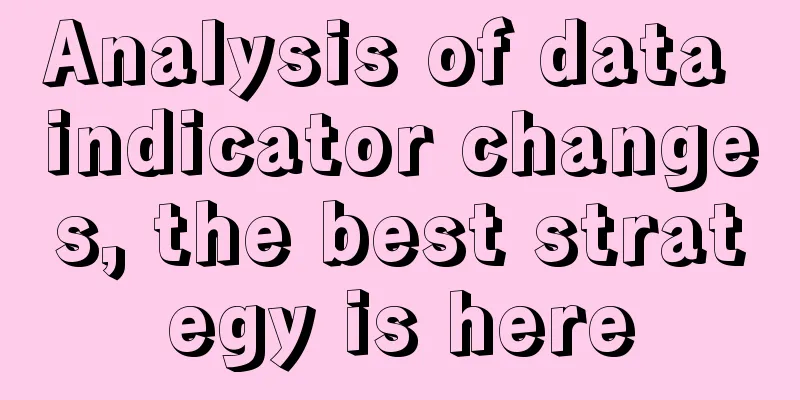Analysis of data indicator changes, the best strategy is here

"Monitoring data and analyzing the reasons for indicator changes" is a common work content of data analysis. This requirement seems simple, but in practice it confuses many students: How big is the indicator fluctuation? Why sometimes the fluctuation does not seem to be big, but the business is very nervous and asks the reason, and sometimes the fluctuation is big but the business is not anxious? The key to solving the problem correctly is not to just talk about numbers, but to understand the business meaning behind the data fluctuations. Only in this way can we know which are real abnormalities and which are normal fluctuations. There are three types of fluctuations that are typical and appear abnormal but are actually normal: 1. Seasonal fluctuations in business indicators 2. Changes in the life cycle of business indicators 3. Business proactive behavior triggers change Therefore, before identifying abnormal fluctuations, you should proactively analyze the historical trends of business indicators, discover seasonal patterns/lifecycle trends, and analyze the impact of business actions on indicators. This will help you establish basic judgment criteria and avoid making low-level mistakes (as shown in the following figure): What we really need to pay attention to are the long-term, continuous changes that go against the normal development trend. These situations often mean that there is a problem with the business and need to be investigated in depth (as shown in the figure below). Even if it is small, it is worth paying attention to fluctuations Typically, for example, there are changes in the two key indicators of revenue and cost. Revenue and cost are the KPI indicators of most companies. Increasing revenue and reducing expenditure is the core task of the company, so these two indicators have clear requirements specific to the month/week/day. Even if the fluctuation is small, it must be tracked down so that the business can be assured. For example, if today's sales revenue KPI is 10 million, and the actual sales revenue is 9.9 million, then it must be an anomaly. As for where the missing 100,000 went, you can break it down by sales channel to find the source of the problem (as shown below). Short-term KPI changes can be explained as "business not performing well", but if the performance is poor for several consecutive weeks, there may be in-depth problems such as poor business capabilities/wrong methods, which need to be further investigated. Hidden problem 1: ROI changes The income/cost indicators can be viewed together, and more discoveries can be made. In theory, income is generated only when there is cost input, and income/cost should occur synchronously in a certain proportion. If the relationship between two indicators is misaligned, there is a high probability of anomalies, such as: Investment continues to grow, but income does not increase... The investment has not been in place, but the income is still rising! These are all problems. At these times, the typical manifestation is that the business ROI is abnormal, either abnormally high or abnormally low. At this time, you have to find out the reason. An abnormally low ROI means that optimization is needed to improve business performance. An abnormally high ROI means that there is something fishy, which is often related to business corruption and waste. Attention! This problem is often overlooked by data analysts, but easily discovered by finance/management. Because when making monitoring reports, revenue/cost are often done separately, and cost classification is based on financial accounts, which data analysts cannot understand. Therefore, when making monitoring reports, try to put revenue/cost KPIs together as much as possible to make it easier to draw conclusions. Hidden Problem 2: Trend Abnormality Sometimes it’s not that the KPI is not up to standard, but that the indicator trend is wrong! For example: Although sales have temporarily met targets, costs are increasing. The trend was obviously good before, but it suddenly turned bad recently. Income growth is getting slower and slower, and is approaching a turning point. These events will cause anxiety among management and business parties, who will then judge them as "unusual movements" and request in-depth analysis. Here, some abnormal movements are caused by business, such as the sudden brake at the end of the month shown in the figure below. Many companies that rely on sales staff have this phenomenon. This is the behavior of sales staff who deliberately postpone orders and hide their performance when they see that their performance is about to be completed. If this happens too often, it will lead to deviations in product stocking, performance accounting, cost control, and business analysis, and it must be checked. Some involve deeper issues, such as: The product life cycle has ended Potential target users are exhausted Marketing stimulation makes people tired These curves show a continuous decline. Once you see signs of decline, you must alert the business side in advance. Because these long-term trends often require testing to confirm, and the handling is also very difficult. If problems really occur, it may be too late to handle them. Hidden Problem 3: Process Changes Many indicator changes come from process indicators, such as exposure, number of user logins, number of visits to a certain business, etc. These indicators are process indicators of KPI indicators, so once there is an abnormal change, it may affect the KPI results. Therefore, it will attract people's attention. The first type: rise and fall together. This is the easiest to understand. For example, if the traffic is small, the income will drop accordingly. This problem can be directly observed with data and is easy to find. It should be noted that if the rise and fall are not synchronized, for example, the traffic increases by 30%, but the conversion increases by only 10%, then it is very likely that a large amount of low-quality traffic has come in, and low-quality traffic is often related to business corruption and waste. Therefore, the rise and fall are not synchronized, which is also abnormal and requires extra attention. The second type: some ups and some downs. For example, although my traffic has decreased, the conversion rate has increased, and the total revenue target has been achieved. Is this situation considered abnormal? Of course it is. Because this change is likely to mean: the shift of user needs, changes in channel characteristics, changes in product attractiveness, and other deep-seated problems. And to confirm the deep-seated problems, complex analysis is required. Therefore, once such a change is discovered, it is necessary to promptly remind the business party and initiate in-depth analysis. The third type: structural transformation. For example, I have three channels, ABC. I used to rely on A, but now A is getting less and less, while C is getting more and more. Is this situation considered abnormal? Of course it is. Because the actual business has deviated from the budget. At this time, you have to consider whether this represents a long-term trend and whether to adjust the budget. This is another complex issue. After discovering such signs, you must remind the business side and initiate in-depth analysis. Hidden problem 4: Related changes Related changes refer to indicators that have problems but are not directly related to the main KPI indicators, but are related to the business. This causes the business side to be very nervous. For example, when a leader wakes up in the morning and sees a popular video criticizing our products, he will definitely not be in a good mood and will ask, "Is there anything unusual?" At this time, even if the KPI indicators are fine, the leader will still be worried. Therefore, it is necessary to combine internal data for interpretation (as shown in the figure below). Note! Related changes may also mean: "The good thing I expected did not happen." For example, I organized a training for the operation staff, and the attendance rate was 90%. After the training, the average score on the exam was 90/100. So I was overjoyed and thought that the event next month would definitely be outstanding. But after the training, there was no difference. Seeing this scene, I would also wonder: "What's going on?!" I would also ask: "Is there anything unusual?" Therefore, when management/business asks, "Is there anything abnormal?", please ask them to explain clearly what is normal! This way, you can truly understand the issues they are concerned about and prescribe the right remedy. To accurately identify business anomalies, you need to: 1. Build a complete data indicator system 2. Clearly understand the position of problem indicators in the system 3. Understand past indicator trends 4. Understand business actions/business expectations 5. Establish an appropriate standard of “normal” This is the only way to avoid just looking at numbers and find out the abnormal problems in the business through data. However, many students are not good at abnormal analysis because they start with a scattered and rough monitoring indicator system, lack of correlation between indicators, and just throw numbers at the business without real monitoring. |
<<: E-commerce agency operation companies have reached a historical turning point
Recommend
Is it useful for restaurants to set up WeChat groups?
Nowadays, any restaurant will add you to a WeChat ...
Shout the right slogan and become the first choice (9-word slogan tips)
When doing marketing, slogans are crucial, and sho...
How to register an Amazon US account? What are the conditions?
Many people go shopping on Amazon. When shopping, ...
What information is needed to register an independent website? How to establish an independent website?
Now there are more and more merchants doing cross-...
Xiaohongshu's spotlight advertising didn't convert? Remember these 10 operational experiences
When spotlighting ads on Xiaohongshu, many operato...
The traffic tide of Douyin determines the fate of merchants
Is the current status of Douyin e-commerce promisi...
6 recent favorite cases
One good idea will light up another. When we appre...
Looking ahead to 2023, what new developments will there be in consumption growth and brand marketing?
As the epidemic is eased, what consumption growth ...
What are the tips for printing Amazon FBA labels? Tips to share
Amazon products are generally stored in warehouses...
What is the Amazon One-Click Listing Global Function? Detailed Introduction
If you are a merchant on Amazon, you must know wha...
How does Pinduoduo achieve high investment and yield?
How to achieve high investment and production is p...
Live slicing doesn’t work anymore?
Is it becoming increasingly difficult to make live...
Traffic + subsidies + global coverage: why does Douyin e-commerce attach so much importance to "key promotion products"
This year, consumers' demands have begun to ch...
What should I do if my temu rating is low? What is the temu rating required for the product to be listed again?
TEMU is a platform that provides reviews of variou...
What are the big promotional activities in the second quarter of Wish?
The second quarter has begun! Wishmas is over, but...









